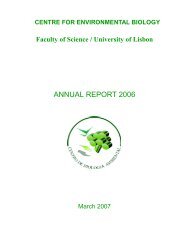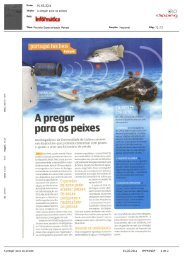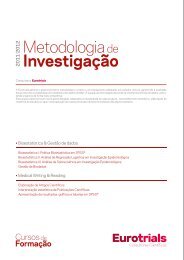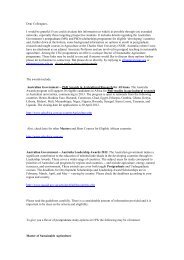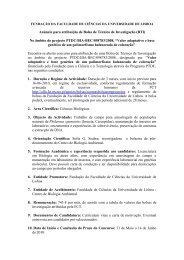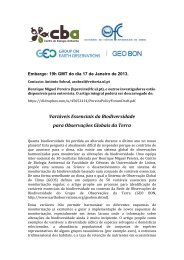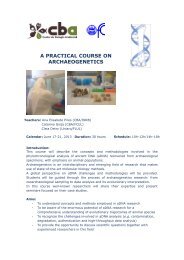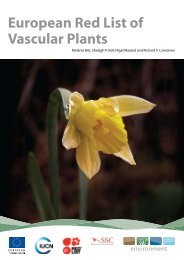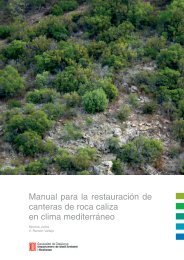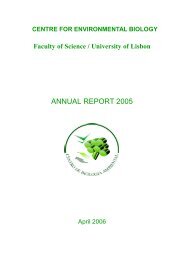Measuring Biodiversity: Obtaining data, assessing its quality and ...
Measuring Biodiversity: Obtaining data, assessing its quality and ...
Measuring Biodiversity: Obtaining data, assessing its quality and ...
You also want an ePaper? Increase the reach of your titles
YUMPU automatically turns print PDFs into web optimized ePapers that Google loves.
<strong>Measuring</strong> <strong>Biodiversity</strong>:<br />
<strong>Obtaining</strong> <strong>data</strong>, <strong>assessing</strong> <strong>its</strong> <strong>quality</strong> <strong>and</strong> generating<br />
measures of different aspects of diversity<br />
Lecturer: Joaquín Hortal (Museo Nacional de Ciencias Naturales – CSIC & Universidade<br />
Federal de Goiás)<br />
Calendar: 10-14 June 2013<br />
Duration: 30 hours<br />
Schedule: 9h-12h <strong>and</strong> 14h-17h, everyday<br />
Objectives: This course offers an overview of the different ways to measure biodiversity, <strong>and</strong><br />
provides tips for the stratification of primary biodiversity <strong>data</strong> <strong>and</strong> the construction of<br />
variables that describe <strong>its</strong> various facets. It also includes an in-depth review of the different<br />
types of <strong>data</strong> used to measure biodiversity <strong>and</strong> their problems <strong>and</strong> limitations.<br />
Overview: <strong>Biodiversity</strong> is a complex phenomenon that includes many different facets <strong>and</strong><br />
functions, covering a wide array of ecological <strong>and</strong> evolutionary characteristics. In spite of this<br />
most studies on biodiversity focus on species richness <strong>and</strong>, to a lesser extent, on the variation<br />
in species composition or the diversity of evolutionary processes. Because of this, many facets<br />
of biodiversity are poorly known. In addition, knowledge about the geographical distribution<br />
of the biota is incomplete <strong>and</strong> spatially <strong>and</strong> taxonomically uneven. The problems of<br />
biodiversity <strong>data</strong> hamper studying the determinants of diversity gradients, <strong>and</strong> limit their<br />
usefulness in conservation planning.<br />
In the first part of the course I will describe the facets of biodiversity that are commonly<br />
studied, with an emphasis on ecological <strong>and</strong> species diversity. This includes richness,<br />
composition, replacement (beta diversity), rarity, endemism, phylogenetic diversity <strong>and</strong><br />
functional diversity. I will also review the different ecological functions that have been<br />
assigned to some of these facets, their possible role in ecosystem functioning, <strong>and</strong> the<br />
relationship between biodiversity <strong>and</strong> some ecosystem services that are essential to the<br />
functioning of the biosphere.<br />
The second part of the course will focus on how to measure biodiversity, with special<br />
reference to <strong>its</strong> geographical – <strong>and</strong> temporal – variations. I will first review the various sources<br />
of information about biodiversity, as well as <strong>its</strong> accessibility <strong>and</strong>/or potential utility. Then I will<br />
show how to use this information to measure different facets of biodiversity. After that, I will<br />
describe the various sources of bias associated with these <strong>data</strong> <strong>and</strong> measures, their origin, <strong>and</strong><br />
the effects they have on the knowledge of biodiversity.<br />
Finally, we will discuss the different ways to correct or mitigate the limitations imposed<br />
by this bias, namely additional sampling, diversity estimators (of richness <strong>and</strong> composition),
<strong>and</strong> predictive models of the geographic distribution of both species <strong>and</strong> different measures of<br />
diversity. We will overview the methods available for these strategies, as well as their logical<br />
order of application <strong>and</strong> <strong>its</strong> usefulness in terms of specific objective of the study <strong>and</strong> the type<br />
of <strong>data</strong> available. We will use several practical examples – including the students’ own work –<br />
to discuss about (1) how to decide the most appropriate sampling plan, (2) <strong>assessing</strong> survey<br />
<strong>quality</strong>, (3) using estimates, (4) how to stratify <strong>data</strong>, <strong>and</strong> (5) developing <strong>and</strong> validating<br />
predictive models of geographic distribution. Finally, we discuss the usefulness of the <strong>data</strong> <strong>and</strong><br />
methods currently available for the study of diversity gradients, community ecology <strong>and</strong><br />
conservation planning.<br />
General Plan:<br />
1. Course Introduction - <strong>Biodiversity</strong>, concept <strong>and</strong> types: genetic diversity, ecological <strong>and</strong><br />
specific - Facets of <strong>Biodiversity</strong>.<br />
2. <strong>Biodiversity</strong> <strong>and</strong> ecosystem functioning.<br />
3. Measures of species diversity: richness, composition, substitution (beta diversity),<br />
rarity, endemicity.<br />
4. <strong>Biodiversity</strong> <strong>data</strong>, <strong>data</strong>bases, <strong>quality</strong> <strong>and</strong> bias.<br />
5. Sampling effort evaluation.<br />
6. Species richness estimators.<br />
7. Survey design.<br />
8. Phylogenetic <strong>and</strong> functional diversity. Species tra<strong>its</strong> <strong>and</strong> functional groups.<br />
Stratification of biodiversity <strong>data</strong>.<br />
9. Species distribution models: theory, utility <strong>and</strong> limitations. Maps of uncertainty.<br />
10. Discussion, synthesis <strong>and</strong> future challenges: good practices in the use of biodiversity<br />
<strong>data</strong>.<br />
Location: Departamento de Biologia Animal (FCUL)<br />
Nº (min, max) students: 10 – 20<br />
Directed to: PhD or MSc students in Ecology, Geography or related areas, <strong>and</strong> postdocs<br />
working in related topics<br />
Fee: free for 1st year PhD students in the Doctoral programme in Biology (FCUL), <strong>Biodiversity</strong>,<br />
Genetics <strong>and</strong> Evolution (UL; UP) <strong>and</strong> Biology <strong>and</strong> Ecology of Global Changes (UL, UA); 20 € for<br />
PhD students from institutions of the PEERS network (CBA, CFE, ABG); 100 € for FCUL Master<br />
students <strong>and</strong> unemployed; 150 € for BTI, BI <strong>and</strong> other PhD students; 200 € for Professional <strong>and</strong><br />
postdocs.<br />
Deadline for applications: May 10 th , 2013<br />
C<strong>and</strong>idates should send a short CV <strong>and</strong> motivation letter explaining why they are interested in<br />
the course, including a brief description of their research projects. Send all information <strong>and</strong><br />
requests to Joaquín Hortal (jhortal@mncn.csic.es).



